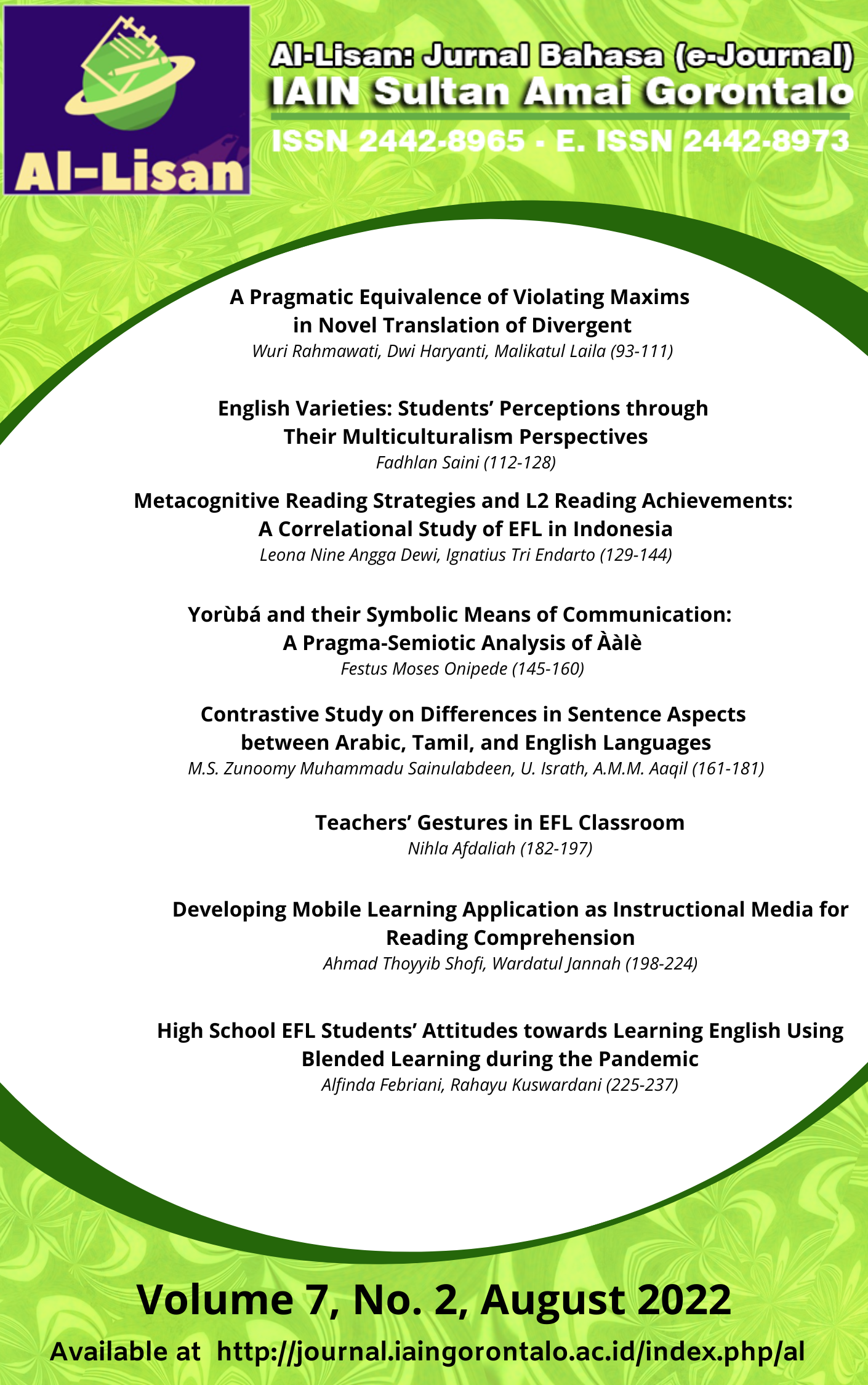ESP Requirements in Vocational Education: Insights from Computer and Network Engineering Department
DOI:
https://doi.org/10.30603/al.v7i2.5197Keywords:
English for specific purposes;, material development;, computer & network engineeringAbstract
This study aims to determine the learning situation and needs of English language specific to the field of computer and network engineering department in vocational schools seen from the perceptions of students, English teachers, and the head of the department. This survey research was conducted in 21 state vocational high schools spread across Gorontalo province involving 211 computer and network engineering students, 21 English teachers, and 21 department heads as respondents. The questionnaire instrument was distributed to students to find out the English language and methods they need according to their major, while interviews were conducted with English teachers and the head of the department to explore information related to the implementation of English language learning at school and what kind of English language methods and materials are needed by students so that they can be useful in the world of work as the students graduate. The questions asked covered the aspects of necessity, lack, and wants. The results show that English learning in vocational schools is still dominantly using general English even though English teachers are well aware of the importance of specific English for the students. The teachers and head departments of computer and network engineering agree to the collaborative teaching method involving both English and the subject-specific teacher to provide a more relevant and specific learning environment in vocational settings.
Downloads
References
Aboe, R. M., & Ismail, A. (2020). Need analysis of English for specific purposes (ESP) at SMK 1 ternate. International Journal of Advanced Science and Technology, 29(7 Special Issue).
Achmad, A. D., Achmad, A., & Putra, Z. M. (2020). Interactive Learning Media Based on Android for Computer Programming Course. IOP Conference Series: Materials Science and Engineering, 875(1). https://doi.org/10.1088/1757-899X/875/1/012040
Albiansyah, A., Prasetyo, A., & Minkhatunnakhriyah, M. (2020). The communicativeness of English tests at vocational high school. TRANS-KATA: Journal of Language, Literature, Culture and Education, 1(1). https://doi.org/10.54923/transkata.v1i1.7
Asmin, A. I. (2019). Teachers’ strategies in teaching english at vocational high school. IDEAS: Journal on English Language Teaching and Learning, Linguistics and Literature, 7(2). https://doi.org/10.24256/ideas.v7i2.1040
Chambers, F. (1980). A re-evaluation of needs analysis in ESP. The ESP Journal, 1(1). https://doi.org/10.1016/0272-2380(80)90007-4
Fadlia, F., Asra, S., Zulida, E., & Santosa, M. H. (2022). Developing ESP based-digital learning materials support students’ needs at Indonesian vocational schools: Perceived quality. Englisia: Journal of Language, Education, and Humanities, 10(1). https://doi.org/10.22373/ej.v10i1.12166
Hunt, A., & Beglar, D. (2005). A framework for developing EFL reading vocabulary. Reading in a Foreign Language. https://doi.org/10.1080/07908310208666643
Lestari, A. R. E., & Martiarini, E. (2021). Content Analysis of an ESP Textbook; English for Vocational High School. Channing: Journal of English Language Education and Literature, 6(2). https://doi.org/10.30599/channing.v6i2.1358
Lockwood, J. (2012). Developing an English for specific purpose curriculum for Asian call centres: How theory can inform practice. English for Specific Purposes, 31(1). https://doi.org/10.1016/j.esp.2011.05.002
Nikoopour, J., & Farsani, M. A. (2011). English Language Teaching Material Development. Journal of Language and Translation, 2(2).
Nuriya Axmedovna, J., Manzura Gapporovna, S., Oyshajon Rozmatovna, A., & Chevar Gayrat qizi, F. (2019). The Importance of Needs Analysis in Teaching ESP. European Journal of Research and Reflection in Educational Sciences, 7(11).
Sakkir, G., Dollah, S., Arsyad, S., & Ahmad, J. (2021). Need analysis for developing writing skill materials using facebook for english undergraduate students. International Journal of Language Education, 5(1). https://doi.org/10.26858/ijole.v5i1.14856
Saragih, E. (2014). Designing ESP Materials for Nursing Students Based On Needs Analysis. International Journal of Linguistics, 6(4). https://doi.org/10.5296/ijl.v6i4.5983
Şendurur, E., Ersoy, E., & Çetin, İ. (2018). The design and development of creative instructional materials: the role of domain familiarity for creative solutions. International Journal of Technology and Design Education, 28(2). https://doi.org/10.1007/s10798-016-9391-y
Stimson, R. J. (2014). Survey research methods. In Handbook of Research Methods and Applications in Spatially Integrated Social Science. https://doi.org/10.4337/9780857932976.00016
Story, D. A., & Tait, A. R. (2019). Survey Research. Anesthesiology. https://doi.org/10.1097/ALN.0000000000002436
Sugiono, P. D. (2014). Metode penelitian pendidikan pendekatan kuantitatif.pdf. In Metode Penelitian Pendidikan Pendekatan Kuantitatif, Kualitatif Dan R&D.
Syifa, T. A., & Safitri, L. (2020). The Need Analysis of Learning Materials for Teaching English for Specific Purpose at 2nd grade Computer Networking Students’ in SMKN 1 Bukittinggi. English Language Teaching and Research, 3(1).
Tomlinson, B. (2011). Materials Development in Language Teaching. Cambridge University Press.
Tsakos, G. (2015). Questionnaire surveys : Subjective Perceptions and Behaviours Key Questions - outline. November.
Downloads
Published
How to Cite
Issue
Section
License
Copyright (c) 2022 Adimawati Helingo, Fadli Setiawan Molou

This work is licensed under a Creative Commons Attribution-ShareAlike 4.0 International License.
Copyright Notice
Authors who publish in Al-Lisan: Jurnal Bahasa (e-Journal) agree to the following terms:
- Authors retain copyright and grant the journal right of first publication with the work simultaneously licensed under a Attribution-ShareAlike 4.0 International (CC BY-SA 4.0) License that allows others to share the work with an acknowledgment of the work's authorship and initial publication in this journal.
- Authors are able to enter into separate, additional contractual arrangements for the non-exclusive distribution of the journal's published version of the work (e.g., post it to an institutional repository or publish it in a book), with an acknowledgment of its initial publication in this journal.
- Authors are permitted and encouraged to post their work online (e.g., in institutional repositories or on their website) prior to and during the submission process, as it can lead to productive exchanges, as well as earlier and greater citation of published work.












